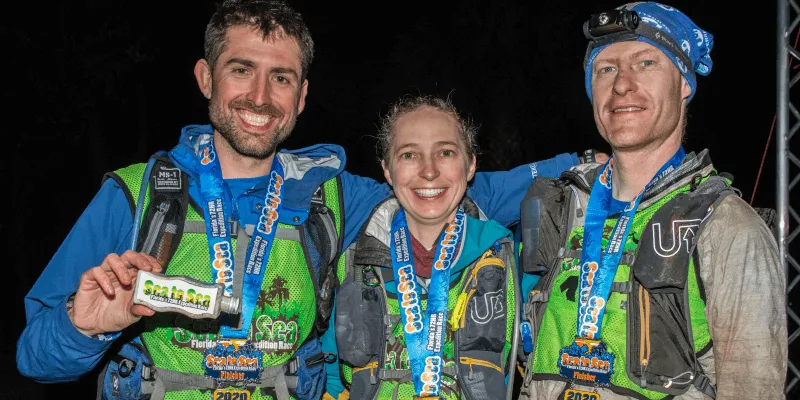It's not unlike a movie — with thrill-seeking heroes facing unanticipated challenges in exotic locations to reach a monumental goal — but adventure racing is real, and for Professor Katheryn “Kit” Vreeland, it is a passion.
Vreeland took first place in the Florida Sea to Sea Expedition with her three-member team, Strong Machine, in February. The team crossed 300 miles of swampy, muddy terrain, through mangrove jungles and tangled brush, by foot, bicycle and kayak - in just 64 hours.
Adventure racing teams use only a map and compass to navigate as they run, bike, paddle, swim and climb over backcountry terrain. They carry all their gear – clothes, food, first-aid supplies, sleeping bag and tarp - and lean into each other’s strengths to cross the finish line.
A lifelong, competitive cross-country runner and triathlete with a fascination for topographical maps, Vreeland finds a unique outlet for her interests in adventure racing.
“I have used each race as a learning opportunity to discover myself,” she says. “How my mind and body react to little sleep, how my cognitive processing is affected, how to fight off the 'sleep monsters,' especially while biking at high speeds!”
“Every piece of this translates into my 'normal' life activities - being aware of my little neuroses that creep in with stress, hunger, tiredness, and being able to tend to and care for myself. To this end, I am better as a health care professional to take care of others,” says Vreeland.
Perceived limits
Pressed to explain what compels adventure racers to willingly endure pain, hunger and exhaustion for days on end, Vreeland admits it’s about facing personal limits in order to discover that they are perceived limits. Adventure racers push past physical, emotional, and mental thresholds to “explore what body, mind and soul can endure and achieve,” Vreeland says.
One example: During a seven-day Nordic Islands Expedition from the mountains of Sweden to the coast of Norway in summer 2019, Vreeland’s team lacked appropriate gear and faced hypothermia. They packed up and kept moving, forgoing sleep for 64 hours.
Her recollection of that frigid night: “The landscape was spectacular and awe-inspiring.” She remembers the low, gentle sounds of sheep, then adds: “one foot goes in front of the other, the legs keep turning the pedals, the pain is felt, embodied, and ignored all at the same time, and the race ends without quitting.”
Another reward of adventure racing, according to Vreeland, is camaraderie. At its core, adventure racing emphasizes team achievement over individual achievement.
“Everyone relies on each other for various roles and responsibilities. You may experience a year’s worth of emotion in a single race, creating a unique trust and intimacy with your teammates, creating a bond for a lifetime,” she says.
Is going 48 hours without sleep really bad for you?
In the classroom, Vreeland’s racing accounts help her students understand the need for careful attention to athletes’ physiological processes and functions, from biomechanics and neuromuscular training to core stability and balance.
“Appropriate management is often the difference between enjoying the season and having no season at all,” she says. She asks her students to consider tough questions, like “Is going 48 hours without sleep really bad for you?” and “Are you causing significant physical damage to your body when you push through tendonitis for days?”
And, perhaps most importantly: “Can you find harmony in your experience as an athlete and your empathy for your patients’ desires to compete through injury and pain? One goal I want for my students as future health care professionals is that they understand and respect their patients in a way that provides empathy for the activities that bring joy and meaning,” Vreeland says.
